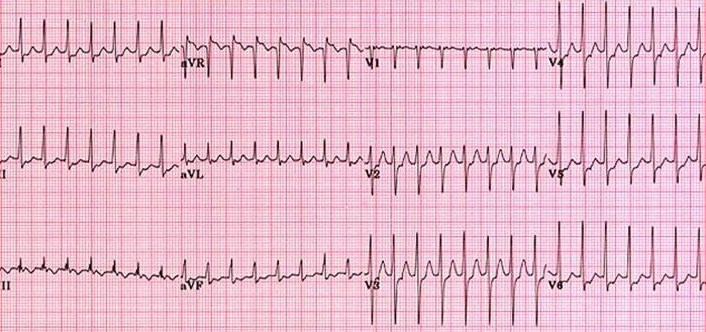A 56-year-old man presents to the emergency department with complaints of chest pain and lightheadedness. On examination, he has a blood pressure of 86/50 mmHg, a rapid and barely perceptible pulse of 160 bpm, and a respiratory rate of 24 breaths per minute. An ECG is obtained, which is shown in the accompanying photograph.
Which one of the following is the most appropriate next step in management?

Correct Answer: E) DC cardioversion
The ECG is characteristic of supraventricular tachycardia (SVT), which presents with tachycardia, regular and monomorphic QRS complexes, and absence of P waves.
SVT is a common condition that can affect individuals of all age groups. Clinical manifestations vary from asymptomatic to severe symptoms.
Common symptoms of SVT include:
Palpitations: >96%
Dizziness: 75%
Shortness of breath: 47%
Syncope: 20%
Chest pain: 35%
Fatigue: 23%
Diaphoresis: 17%
Nausea: 13%
Rare complications of paroxysmal SVT include myocardial infarction, congestive heart failure, syncope, and sudden death.
Acute management of SVT involves controlling the rate and preventing hemodynamic collapse. Patients with hemodynamic instability (hypotension, chest pain, dyspnea, or confusion) should receive immediate cardioversion after sedation.
In this case, the patient has a systolic blood pressure of less than 90 mmHg, indicating hemodynamic instability. Therefore, DC cardioversion is the most appropriate next step.
If the patient were stable, initial management would include vagal maneuvers. If unsuccessful, adenosine can be used, followed by AV nodal blocking agents such as calcium channel blockers (diltiazem or verapamil) or beta-blockers (metoprolol).
Incorrect options:
A) Atropine and D) Pacemaker insertion are used for symptomatic bradycardia, which is not applicable in this case.
B) Intravenous diltiazem and C) Intravenous metoprolol are used for stable SVT, not unstable cases.
